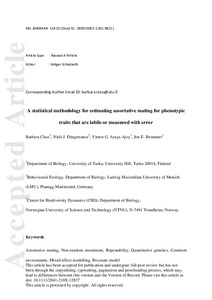A statistical methodology for estimating assortative mating for phenotypic traits that are labile or measured with error
Yimen G. Araya-Ajoy; Barbara Class; Niels J. Dingemanse; Jon E. Brommer
A statistical methodology for estimating assortative mating for phenotypic traits that are labile or measured with error
Yimen G. Araya-Ajoy
Barbara Class
Niels J. Dingemanse
Jon E. Brommer
British Ecological Society
Julkaisun pysyvä osoite on:
https://urn.fi/URN:NBN:fi-fe2021042717480
https://urn.fi/URN:NBN:fi-fe2021042717480
Tiivistelmä
- Assortative
mating in wild populations is commonly reported as the correlation
between males’ and females’ phenotypes across mated pairs. Theories of
partner selection and quantitative genetics assume that phenotypic
resemblance of partners captures associations in “intrinsically
determined” trait values. However, when considering traits with a
repeatability below one (labile traits or traits measured with error),
the correlation between phenotypes of paired individuals can arise from
shared environmental effects on the phenotypes of paired individuals or
correlated measurement error. - We introduce statistical
approaches to estimate assortative mating in labile traits or traits
measured with error in the presence of shared environmental effects.
These approaches include (1) the correlation between the mean phenotypes
of males and females, (2) the correlation between randomized values of
individuals and (3) the between-pair correlation derived from a
bivariate mixed model. - We use simulations to show that the
performance of these different approaches depends on the number of
repeated measures within individuals or pairs, which is determined by
study design, and rates of survival and divorce. - We conclude
that short-term environmental effects on phenotypes of paired
individuals likely inflate estimates of assortative mating when not
statistically accounted for. Our approach allows investigation of this
important issue in assortative mating studies for labile traits (e.g.
behaviour, physiology, or metabolism) in both socially monogamous and
other mating systems, and groupings of individuals outside a mating
context.
Kokoelmat
- Rinnakkaistallenteet [19207]
